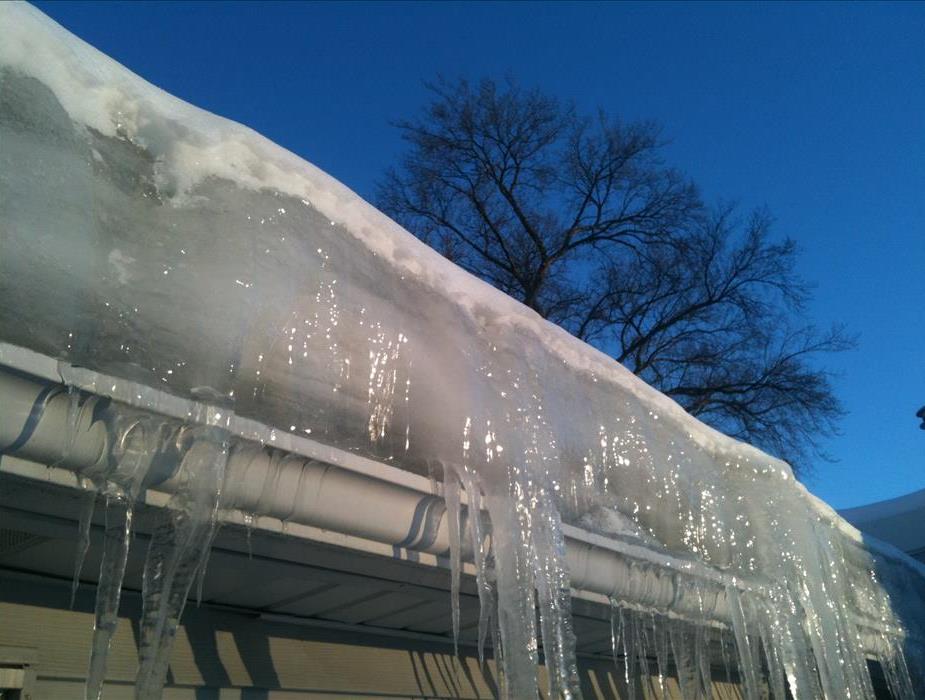Archived Blog Posts
Winterizing your AC Unit
9/28/2020 (Permalink)
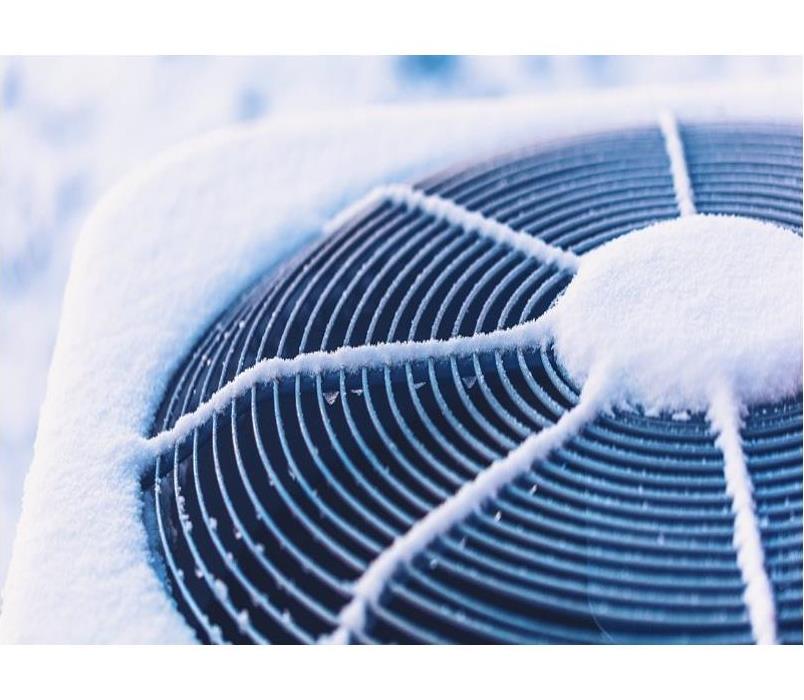 A close up of a frosty top of AC Unit. Lake Country, BC
A close up of a frosty top of AC Unit. Lake Country, BC
As the warm summer days fade to fall weather, it's time to winterize your AC unit. Winterizing your central air conditioner prevents rust damage and keeps rodents from nesting inside.
4 Easy Steps:
- Remove leaves, branches and any other debris. Use a garden hose to rinse the unit- removing bugs, dirt and dust. Allow the HVAC unit to dry completely.
- Locate the electrical circuit. It usually has a plastic or metal lid. Remove the lid and flip the switch to cut power supply. (This prevents the unit from turning on during a warm winter day, which will keep water out of the unit that could freeze overnight and cause potential damage.)
- Install tubular foam or rubber pipe insulation with tees and elbows around pipes to protect against freezing.
- Cover the HVAC unit with a waterproof air conditioner cover, or use a tarp with bungee cords/vinyl tie-downs and a piece of plywood and/or brick to further secure the cover and protect the unit.
Throughout winter, be sure to remove snow, ice and debris from the top of your AC unit. Adjust the cover to keep in place. These simple steps will help prolong the life our your unit and ensure when the warm weather returns your ready.
Improving Air Quality in Your Home
9/17/2020 (Permalink)
 View of heavy wildfire smoke blanketing Okanagan Lake at sunset. Kelowna BC, September 2020
View of heavy wildfire smoke blanketing Okanagan Lake at sunset. Kelowna BC, September 2020
With thick smoke drifting in from wildfires in Washington state, Oregon and California, the entire Okanagan has been sitting at high-risk for air quality. Many of us have been staying indoors, but the air outside is constantly entering our homes.
There a few tips and best practices you can incorporate to improve indoor air quality.
- Running central air or air conditioning units during a wildfire is safe. This is because the outside air isn’t replacing your indoor air with smoke. The unit is simply expelling hot air and exchanging it. Tip: Keep the fresh-air intake on your machine closed. Filters should be as clean as possible and changed frequently during smoky events to reduce the amount of smoke particles. Central air systems should be set to recirculate to avoid drawing in smoky air.
- Air-sealing your home is one of the best ways to improve energy efficiency and limit the amount of outdoor air that enters. While air sealing prevents the loss of heated or cool air and conserve energy, it also prevents smoke from wildfires from entering your home. Air-sealing is the process of filling in gaps, cracks, and other spaces where air can find a pathway into your home.
- Houseplants- Similarly to going outside to get fresh air and relieve stress, using houseplants incorporates those properties inside your home. Houseplants have the ability to naturally filter air. Place houseplants in different areas of the home (1 plant per 100 sq ft) to get the maximum benefit. According to a study by NASA, certain plants are better at eliminating significant amounts of benzene, formaldehyde and trichloroethylene than others. The top plants for air purification are Golden Pothos, Boston Fern, Snake Plant, English Ivy, Spider Plant and many more.
- Activated Charcoal, also known as active carbon. Activated charcoal air filters are a great way to naturally filter and purify the air quality within your home. These carbon air filters can be easily found in stores or online and the charcoal will absorb toxins in the air without releasing any odor.
- Clean Air Filters & Air Ducts- One of the easiest ways that you can improve the air quality within your home is to regularly change the air filter within your heating/cooling system (every 2 to 3 months). Choose a HEPA filter in order to effectively clean the air of contaminants in your home.
Home Fire Safety Checklist
8/17/2020 (Permalink)
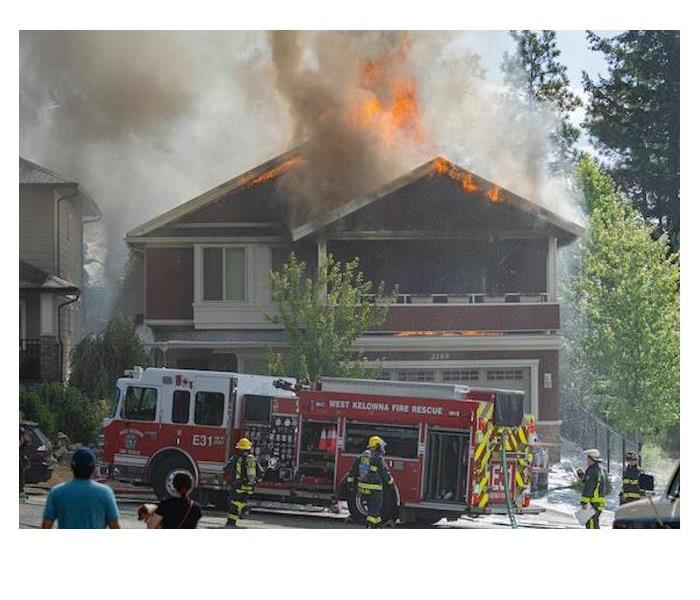 Fire fighters extinguishing a house fire in West Kelowna, BC
Fire fighters extinguishing a house fire in West Kelowna, BC
A fire in your home is devastating, and sadly many times could have been avoided. Ensuring your home is fire safe on a regular basis is crucial for prevention. Below is a fire safety checklist to use. Protect what’s most important…your family, loved ones and home.
- Ensure each level of your home has a working fire alarm and carbon monoxide detector
- Clean vents/air ducts & dryer vent
- Check appliances (even hair dryers and lamps) for worn or frayed cords (Damaged cords should be replaced and discarded)
- Avoid “knock-off” electrical products (these products can easily overheat or short circuit)
- Check extension cords and wall sockets- do not overload
- Do not run cords under rugs or carpeting
- Change your air filter and inspect your furnace
- Check your range hood and fan are fully vented and remove greasy buildup
- Create a fire escape plan with your family
- Prepare a home emergency kit
- Create a home inventory of your belongings (Take pictures or make a video)
- Invest in a fire proof safe to keep all your irreplaceable/important documents protected
Did you know? According to the province of BC, in 43% of home fires causing a loss of life, there was no working smoke alarm. Be prepared, be safe.
The Importance of Drying & Dehumidification
8/10/2020 (Permalink)
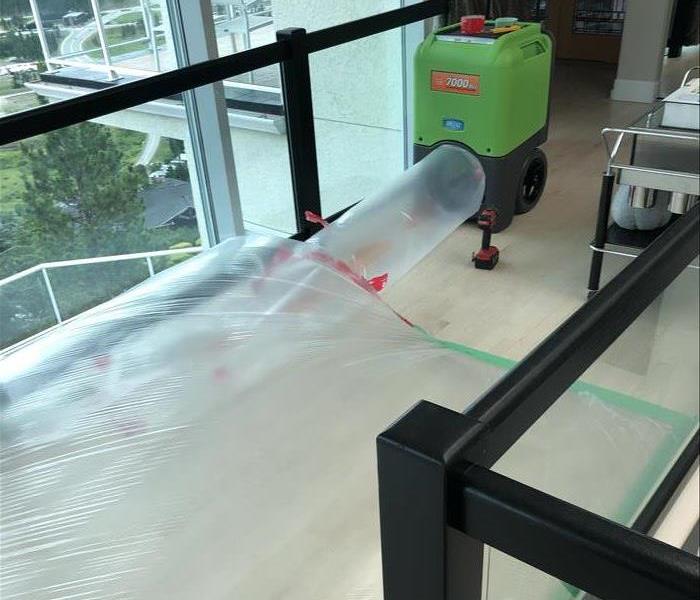 Drying flooring using SERVPRO's advanced equipment in a home in West Kelowna, BC
Drying flooring using SERVPRO's advanced equipment in a home in West Kelowna, BC
Once your home has experienced water damage, just removing the visible water does not eliminate all of the moisture. Water can pool behind walls & floors, and soak into porous material.
Majority of your home is made porous materials. Wood, drywall, flooring, and other items may appear to be dry after water removal, but in fact they retain a significant amount of water. If this water is not addressed materials can warp, swell, or create an ideal environment for mold to grow, causing even more significant damage to your property. Mold can start growing within 48 hours and cause structural damage down the road, as well as potentially causing health issues to those living in your home.
Consider water in 3 states: standing, absorbed, and evaporated. During and after a water emergency, all three of these states are present. Once the standing water has been removed, drying and dehumidifying need to follow.
With SERVPRO’s moisture detection equipment, we are able to identify all affected areas. This allows us to strategically place our drying & dehumidification equipment for maximum effectiveness, removing both the visible and non-visible moisture.
SERVPRO of Kelowna’s Water Drying Process:
Summer Home Maintenance
7/14/2020 (Permalink)
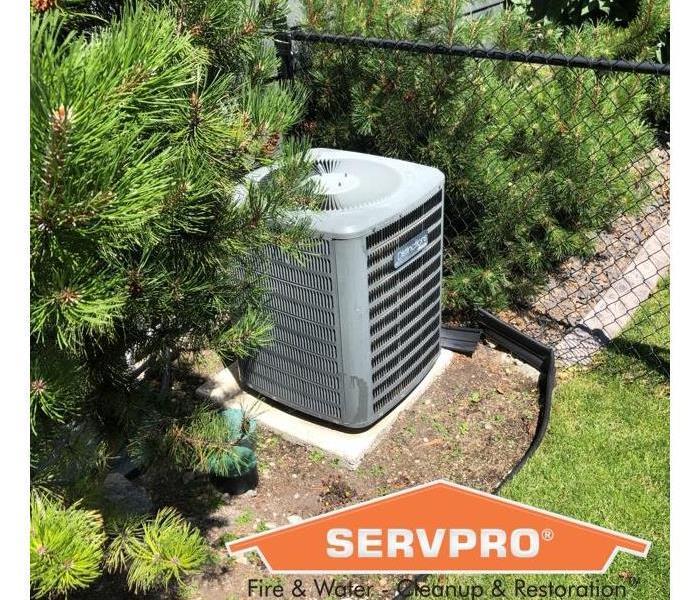 Recently cleaned and maintenance air conditioner in Lake Country, BC
Recently cleaned and maintenance air conditioner in Lake Country, BC
Just like you need to wipe counters, clean floors & bathrooms to keep your home usable and clean, you need to clean and maintain other parts of your home. If you don't, you will end up having your home run less efficient or even worse experience possible fire or water damage.
When you maintain your home, you keep it running efficiently, as well as reducing the likelihood of potential water or fire damage. Not to mention it will save you money with lower utility bills.
Here are some quick and easy summer maintenance tips:
- Switch off your humidifier and use a dehumidifier instead
- Replace air filters throughout your home
- Look at the condition of your roof. Consider having it professionally inspected
- Inspect weather-stripping, caulking and vents for any blockages and/or cracks. Repair as needed
- Change/clean your central air conditioner filter. Book annual maintenance
- Inspect the irrigation lines and valves for leaks
- If your planning on a trip, ensure you have someone checking on your home for leaks/damage regularly
Staying on top of things with minor fixes and maintenance will help you to avoid big problems later down the line.
Are you Flood Ready?
7/9/2020 (Permalink)
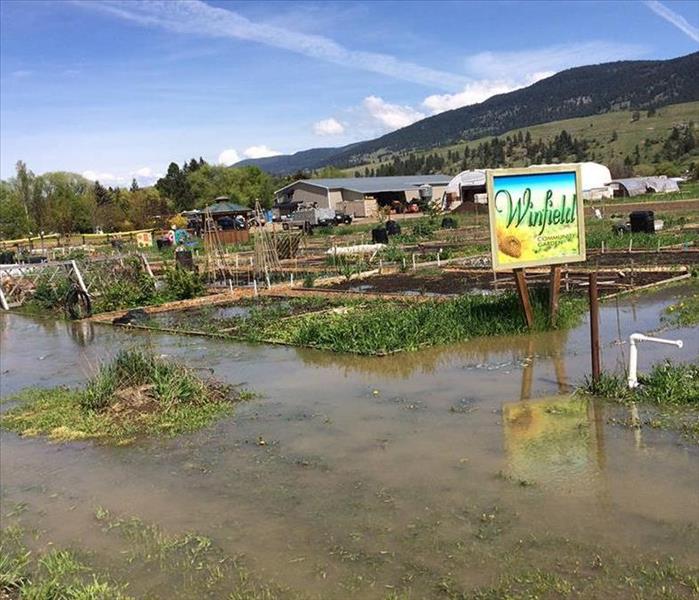 Flooded community garden in Lake Country in 2017 from high water levels and rain.
Flooded community garden in Lake Country in 2017 from high water levels and rain.
There have been a number of extreme flooding events occurring in Canada over the last few decades. Sadly, as a result of climate change, these events are increasing in both frequency and magnitude.
Floods can happen anywhere and at any time of the year here in the Okanagan. It’s important to take time to understand and prepare your home. Below are some helpful tips to ensure your home/property is flood ready
- Downspouts should extend at least 2m from your basement wall. Water should drain away from your property
- During heavy rainfall, check that your roof and eaves are draining properly
- Use rain barrels to catch water runoff
- Put weather protection sealant around basement windows and ground-level doorways
- Install flood shields/barriers for basement windows and doors. The tops of the shields should extend above ground level
- Raise large appliances, furnaces, hot water heaters, and electrical panels up on wood or cement blocks above the potential water level
- Make sure your plumbing system and drains follow all code requirements
- Install backwater valves or plugs for drains, toilets and sewer connections
- Check to ensure your sump pump is working. Consider installing a battery-operated backup encase of a power outage
- Ask your insurer about your flood insurance and review the coverage
- Create an emergency kit
Take the Government of Canada’s flood ready quiz today! https://www.canada.ca/en/campaign/flood-ready/quiz.html
Back to Business: Shaw Kelowna is Certified: SERVPRO Cleaned!
6/17/2020 (Permalink)
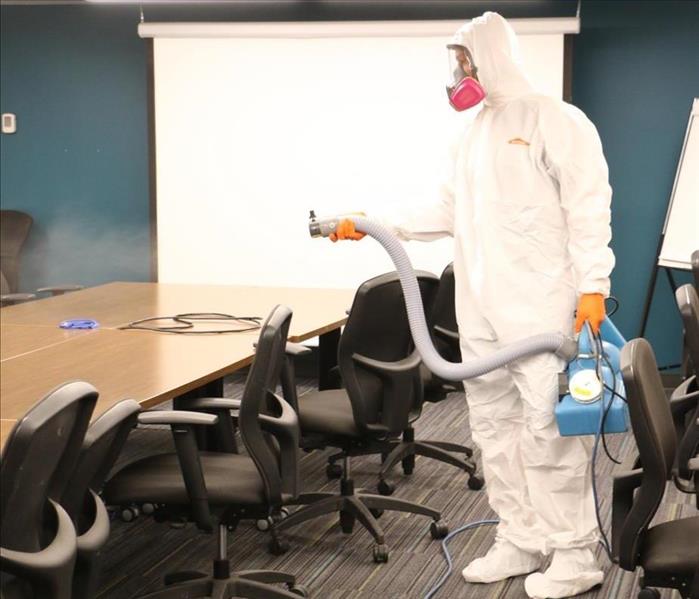 Cleaning certified technicians spraying EPA-approved emerging pathogen disinfectant in one of the office spaces at Shaw Communications in Kelowna, BC.
Cleaning certified technicians spraying EPA-approved emerging pathogen disinfectant in one of the office spaces at Shaw Communications in Kelowna, BC.
SERVPRO® of Kelowna had the pleasure to complete our "Certified: SERVPRO Cleaned" service at Shaw in Kelowna, BC earlier this month.
As their staff re-enters the workplace, they can be reassured Shaw took the extra steps in preventing the spread of COVID19.
We have experience in dealing with biological contaminants. This proactive viral pathogen cleaning program goes well beyond janitorial cleaning. Our product line carries EPA-approved emerging pathogens claims & hospital-grade disinfectants. We spray the entire space with disinfectant, as well as wipe all high touch surfaces. The service is safe, affordable and requires no wiping after we complete the work!
Call us today for a Certified: SERVPRO Cleaned consultation. We service the ENTIRE Okanagan valley. Let us help you get back to business!
Aberdeen Hall is Certified: SERVPRO Cleaned as Students Return to the Classroom
6/9/2020 (Permalink)
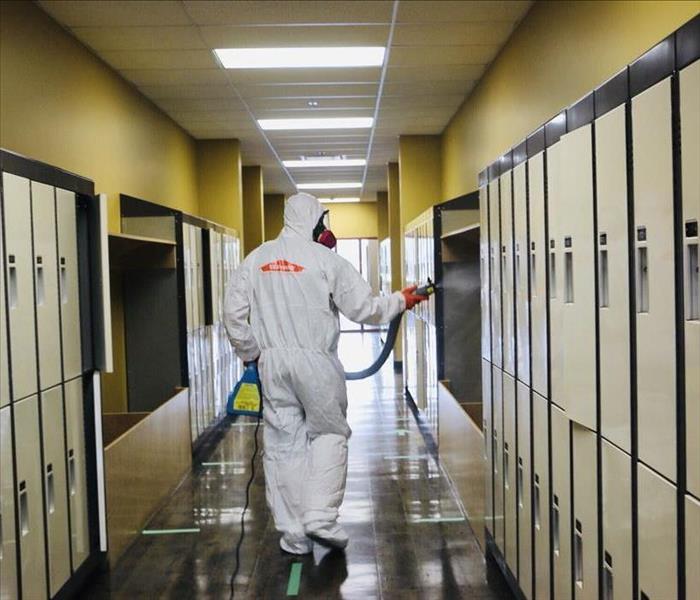 A technician spraying EPA approved, hospital grade disinfectant on lockers at Aberdeen Hall Preparatory School in Kelowna BC.
A technician spraying EPA approved, hospital grade disinfectant on lockers at Aberdeen Hall Preparatory School in Kelowna BC.
Disinfecting is a vital part of preventing the spread of COVID-19 and essential to the safe return of students and staff back into the classroom.
As members of the Okanagan community and with many of our own staff having school aged children; our top priority is the health and safety of the students and staff as some return to class this June.
Our team had the pleasure and opportunity to assist in the transition back to school; completing a thorough Certified: SERVPRO Cleaned service at Aberdeen Hall Preparatory School last weekend.
Certified: SERVPRO Cleaned is a proactive viral pathogen cleaning program that goes well beyond normal janitorial cleaning. The service follows processes and procedures that adhere to the standards set by the Public Health Agency of Canada. We use EPA-Approved Hospital-Grade Disinfectants certified for direct food contact surface use. Meaning its safe for you, but not for viral pathogens. Our technicians have advanced training that covers disinfection and the proper use of personal protective equipment. Improper use of products or cleaning methods can actually spread the microorganisms that are responsible for infections.
It was a unique experience to walk through the empty halls and classrooms at Aberdeen Hall. Seeing water fountains closed, distance markers and arrows on the floor. Desks spaced 6 feet from one another and safety & closure notices up on doors confirmed to us that the administration and staff at Aberdeen Hall were doing everything they could to keep their students safe.
"Our staff and faculty have worked diligently to ensure that everyone who returned to Aberdeen Hall felt comfortable in doing so. The health and safety of our students and staff has always been our #1 priority and this message rings true now more than ever. We're very happy with the thorough fog cleaning service provided by SERVPRO last Saturday and feel confident in the knowledge that we have adhered to the highest possible safety standards as we welcome our students back to campus. SERVPRO was very professional, knowledgeable and a pleasure to work with. We are so appreciative to them for reaching out to our school and providing us with this service." - Lindsay Grieve, Director of Operations Aberdeen Hall Preparatory School
As the SERVPRO team completed the disinfecting process in each classroom, hall and office; it was heart warming knowing that we were assisting in ensuring the school was appropriately disinfected. Further providing reassurance that this wonderful school is safe.
SERVPRO of Kelowna is proud to be Here to Help®
Certified: SERVPRO Cleaned – a defensive cleaning program
5/27/2020 (Permalink)
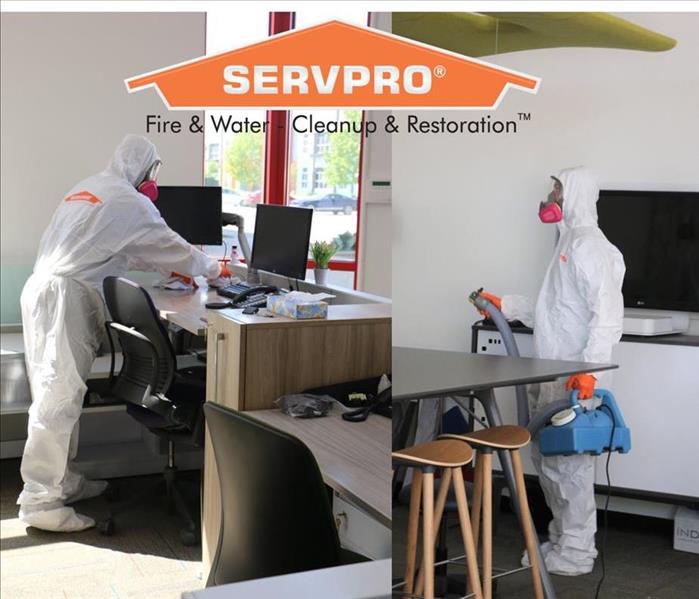 A technician spraying SERVPRO disinfectant and wiping high touch-points at a local furniture business in Kelowna, BC.
A technician spraying SERVPRO disinfectant and wiping high touch-points at a local furniture business in Kelowna, BC.
Let us help you get back to business
As our communities re-open, we’re all moving back toward a new kind of normal. The expectations of visitors, customers, and employees who come into our establishments have evolved, and staying safe and well is a top concern. The global COVID-19 pandemic has changed what it means to be clean, and we’ve developed a program to help your business meet the new higher standard of clean that is now expected.
Certified: SERVPRO Cleaned is a defensive cleaning program we’re offering to businesses and commercial locations to address the current COVID-19 pandemic. This proactive viral pathogen cleaning program goes well beyond janitorial or carpet cleaning. By choosing Certified: SERVPRO Cleaned, you, your employees, your customers, and your community can rest assured that you’ve selected a higher cleaning standard – you are Certified: SERVPRO Cleaned.
Extensive training and specialized products
As the #1 choice in cleanup and restoration*, we stand on more than 50 years of experience and expertise to help your business become Certified: SERVPRO Cleaned. Beyond fire & water, SERVPRO professionals are trained and experienced in biohazard decontamination and chemical spills – always adhering to the cleaning and decontamination standards set by the Centers for Disease Control and Prevention and local authorities.
From formulating and creating our proprietary cleaning products, like SERVPROXIDE, at our headquarters in Gallatin, TN, to taking the utmost care while disinfecting, we will ensure you and your business are set up to inspire consumer confidence as the economy continues to reopen.
3 C’s – Consult, Clean, and Certify
When the stakes are this high, you want a partner who has developed an industry leading, proprietary training program, cleaning solutions, and remediation processes over decades. We’ve cleaned up some of the most challenging biohazards imaginable. Certified: SERVPRO Cleaned reflects our unique experiences and capabilities. The program is grounded with our unique 3 C’s: Consult, Clean, and Certify.
- Consult – Every business is different, which is why you’ll be assigned a Cleaning Protocol Consultant who understands your business and will create a cleaning program to meet your specific needs. This program will be developed based on your business type, size of space, amount of high frequency touch-points, foot traffic and congestion points.
- Clean – Based on your specific business needs, your location will undergo a thorough, deep clean, using exclusive cleaning products, according to protocols set forth by the CDC. Our employees have years of experience, and we will go beyond the scope of work that regular janitorial staff perform. Cleanup procedures generally include cleaning of porous and non-porous surfaces, disinfecting of non-porous surfaces, cleaning and disinfecting of equipment, tools, and/or supplies used for cleanup process, and disposal of hazardous materials. In the event of a suspected or confirmed COVID-19 event, we will be there cleaning within 24 hours to ensure you get back to business as quickly as possible.
- Certify - Once your business location has been Certified: SERVPRO Cleaned, you will gain access to proprietary signage, digital emblems, and other collateral that communicates that you’ve selected a higher standard of clean available to help protect your employees and customers. And because we add the day, month, and year to that proprietary stamp of clean, your guests will know that not only did you choose Certified: SERVPRO Cleaned, but that your location is being cleaned regularly at this standard.
Call today for a Certified: SERVPRO Cleaned consultation
We’re Here to Help – 24 hours a day, seven days a week – until life is back to normal in the communities we all call home.
Call SERVPRO of Kelowna today at 250-899-9789 for your Certified: SERVPRO Cleaned consultation.
* #1 Choice in cleanup & restoration based Commercial Attitude & Usage Tracking study. Polling 816 commercial business decision makers on first choice for future needs related to cleanup & restoration work. Study conducted by C&R Research: October 2019
Certified: SERVPRO Cleaned means professionally trained SERVPRO franchises perform the requested cleaning, sanitizing and disinfection services according to proprietary SERVPRO protocols and recognized industry and CDC standards with EPA approved cleaning products to deliver a SERVPRO certified cleaning experience. Each SERVPRO franchise is independently owned and operated.
Unwanted Water In Your Home? 5 Steps To Take To Prevent Further Damage
5/5/2020 (Permalink)
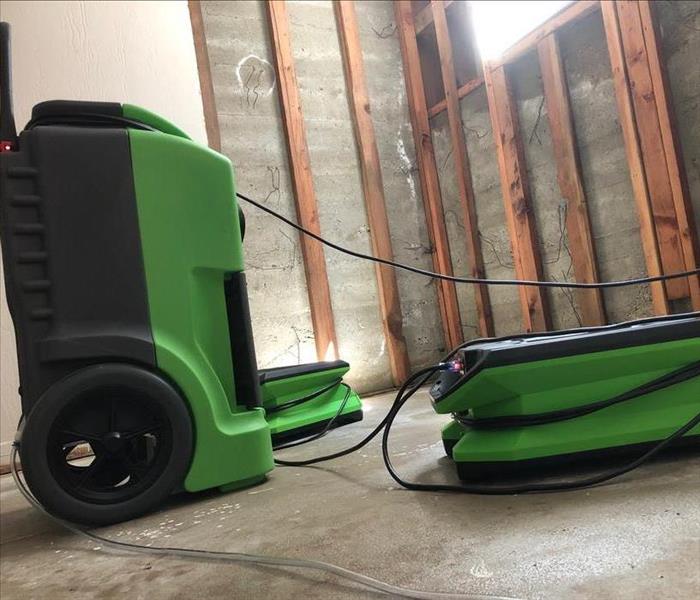 Professional water drying equipment set up in a home that recently experienced water damage.
Professional water drying equipment set up in a home that recently experienced water damage.
Flooding can be the result of weather or home issues, including plumbing failures. Unwanted water in your home can be very traumatic and overwhelming.
Here are 5 steps to take when you have unwanted water in your home:
- Stop the Water -Unless the flooding is due to an act of nature, find the source of the water and turn it off. The fastest way to stop water is to turn off the main water valve.
- Turn Off the Electricity -Turn off electrical breaker
- Take pictures - Document, document, document! -Before any restoration begins ensure you document the damage and your belongings for insurance purposes.
- Call SERVPRO - SERVPRO can handle the water removal, structural drying, and any mold remediation. Time is of the essence when dealing with water! Calling in the professionals to inspect the damage and begin the drying process can save your belongings, as well as significantly reduce damage and restoration/repair costs. (Not to mention prevent mold growth)
- Call your insurance company to begin the claims process.
In addition, the Canadian Red Cross has a great article about what to do before, during and after a flood caused by weather: https://www.redcross.ca/how-we-help/emergencies-and-disasters-in-canada/types-of-emergencies/floods
Vinegar: A Non-Toxic Home Cleaning Option
4/17/2020 (Permalink)
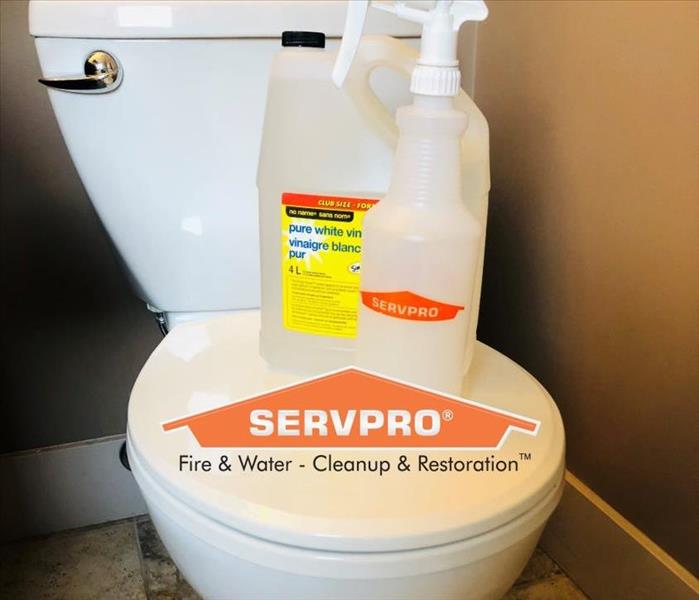 Make a homemade vinegar cleaning solution to clean bathrooms- including toilets.
Make a homemade vinegar cleaning solution to clean bathrooms- including toilets.
A mixture of white vinegar, water, and dish soap can tackle some of the dirtiest jobs in your home. Create this solution by mixing one-part vinegar to one-part dish soap. Then add water to dilute, depending on how potent you want the solution. Add to a spray bottle and VOILA, a DIY homemade vinegar cleaner.
Vinegar is a fabulous chemical free bathroom cleaner, removing soap scum from bathtubs, showers, sinks, and dirty toilets. Vinegar also makes a great alternative to drain cleaners. To do this boil a litre or so of water and pour it down the drain. After that, combine equal parts water, baking soda, and cleaning vinegar (one cup of each) and pour it down the drain. Cover the drain and let it sit for 5-10 minutes. Finally, flush it all down with more boiling water. Ta-da….smelly odors and clogs have been removed!
While vinegar is a fantastic cleaner and you can use in practically every room in your home, it doesn't mean that vinegar is a good cleaner for every surface! Never use vinegar to clean marble, granite, or soapstone surfaces. This is because the acid can cause natural stones to pit and lose their shine. Also avoid cleaning knives and any solid wood furniture as it can ruin the finish.
Lastly, vinegar can have a very potent smell. Add a few drops of your favorite essential oil and it will easily cut the odor. Enjoy and keep cleaning!
COMING SOON: Canadian flood season
2/24/2020 (Permalink)
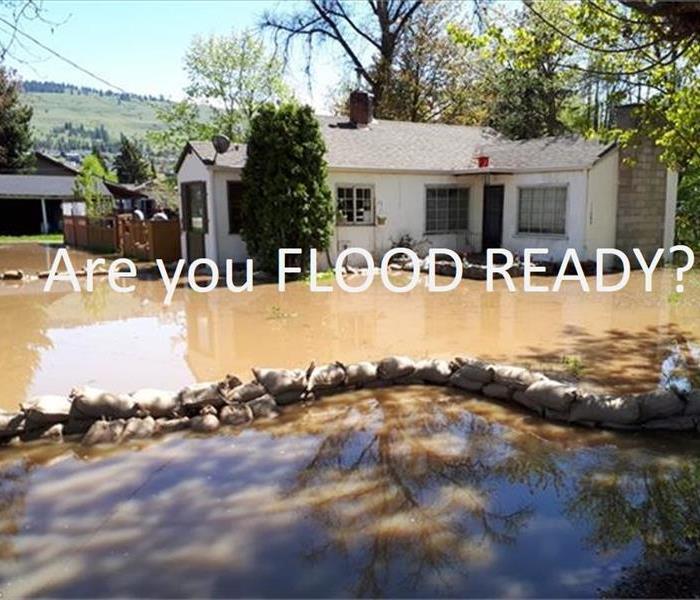 Flooded home and street in Lake Country BC June 2017
Flooded home and street in Lake Country BC June 2017
Did you know flooding is the most frequent natural disaster in Canada?
Some of us are still dealing with below 0 temperatures and snow, but Spring is just around the corner. When temperatures rise, we all need to be ready for our Okanagan thaw.
Here’s a checklist to prepare your home in case of flooding:
- Have an emergency plan in place. Know your evacuation routes.
- Know the flood risk in your community. (contact your municipality)
- Know what type of flood insurance you have with your policy!
- Do you have overland water coverage? Sewer backup coverage? This coverage is not automatic and needs to requested and added to your policy for an additional charge.
- Monitor local weather and alerts
- Protect your valuables in waterproof containers. Place them above potential water levels.
- Have an emergency bag, or at least a list of what you need if you need to evacuate at a moments notice! Ensure to include all vital documents
- Driver’s license, Birth certificates or citizenship documents, Passport(s), Marriage documents, Family vaccine records, Insurance policy numbers, Living wills, Property records, Financial records, like prior tax returns
- Video/document your home and all it’s belongings.
- Put sealant around basement windows and the base of ground-level doors.
- Remove built-up debris from window wells and by doors.
For more information to ensure your home is #FloodReady visit the Government of Canada’s website https://www.canada.ca/en/campaign/flood-ready.html
2020 Home Safety Checklist
1/2/2020 (Permalink)
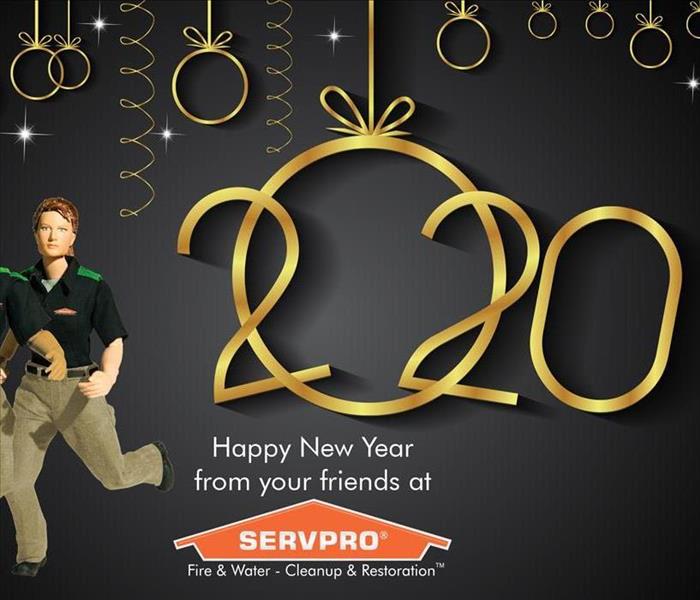 Wishing a safe and happy 2020.
Wishing a safe and happy 2020.
Happy New Years! Start the year off right.....Keep your family and possessions safe by following this home safety checklist:
- Ensure each level of your home has a working fire alarm and carbon monoxide detector
- Create a fire escape plan with your family
- Prepare a home emergency kit
- Invest in a fire proof safe to keep all your irreplaceable/important documents protected
- Get your vents/air ducts & dryer vent cleaned!
- Check appliances (even hair dryers and lamps) for worn or frayed cords. Damaged cords should be replaced and discarded.
- Avoid “knock-off” electrical products. (these products can easily overheat or short circuit)
- Check extension cords and wall sockets- do not overload
- Don’t run cords under rugs or carpeting.
- Change your air filter and inspect your furnace
- Check your range hood and fan are fully vented and free of greasy buildup
- Check your basement for foundation cracks or damage
Lastly, create a home inventory of your belongings. Take pictures or make a video. Keep those receipts! Take pictures of receipts and file them. If you have to make a claim you will need proof of purchase!
Wishing you all a great start to 2020. For more tips, check out our other blogs at https://www.SERVPROkelowna.com/blog/
Protect your home from water disasters!
12/19/2019 (Permalink)
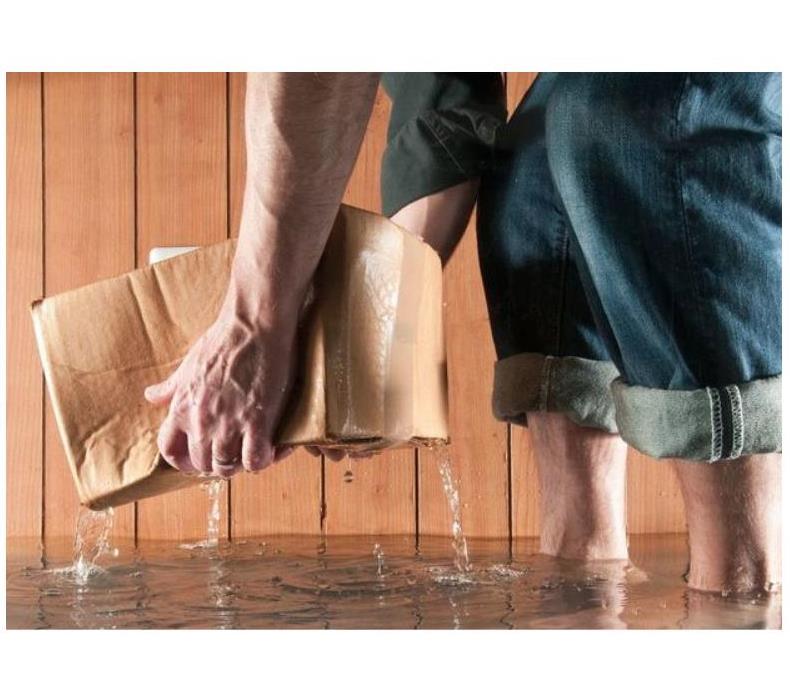 Flooded basement (PM Images / Getty Images)
Flooded basement (PM Images / Getty Images)
Water damage is one of the most common and costly disasters your home can experience. Protect your most important asset against water damage. In the case of an emergency call SERVPRO Kelowna at 250-899-9789 and follow these tips until we arrive https://www.SERVPROkelowna.com/water-damage-tips
Properly maintaining your home is the best ways to prevent water damage/disasters.
- Know the location of the main water shut-off valve in your home.
- Install an emergency pressure release valve in your plumbing system.
- Inspect all appliance hoses and faucets semi annually
- Inspect showers, tubs and sinks on a regular basis
- Check plumbing and heating pipes.
- If you're heading on vacation, have a friend or family member checking on your home and shut off the water supply to the washing machine before you leave
- Check for cracks in your basement foundation and floors.
And remember to protect your treasured memories before disaster happens. Store your valuables and memorabilia in waterproof bins or fire safes. Keep them stored on shelving and off the floor.
Time is key in the event of water leaks or disasters. There is a water damage
Is there mould in my home?
11/20/2019 (Permalink)
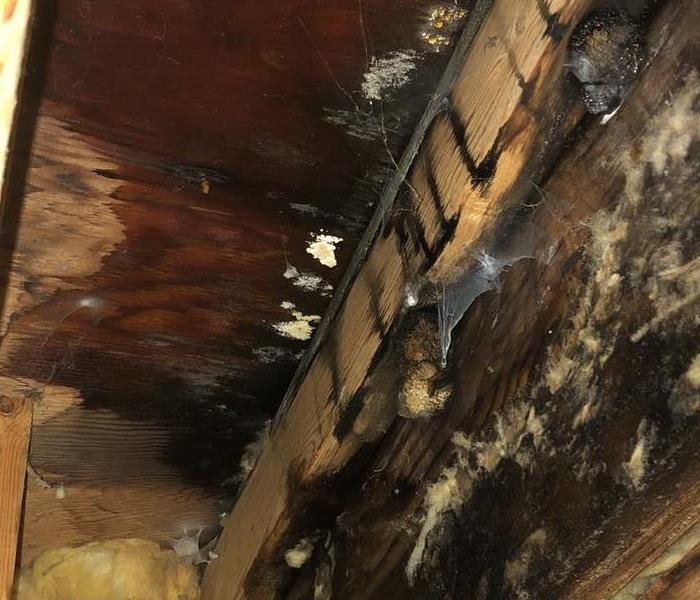 This is extensive mould growth under floorboards after water damage occurred slowly from a kitchen sink leak.
This is extensive mould growth under floorboards after water damage occurred slowly from a kitchen sink leak.
Health Canada considers indoor mould growth to be a health hazard. Some people are more susceptible than others to mould. Infants, children, the elderly and those with existing health problems such as breathing difficulties are more at risk.
People sensitive to mould are more likely to have:
- eye, nose and throat irritation
- coughing and phlegm build-up
- shortness of breath
- worsening of asthma symptoms
Mould growth can be sneaky and can hide behind walls, floors or above ceiling tiles. It is important to check for the presence of mould anywhere that is damp or humid in your home on a regular basis. If you have experienced water damage in your home, you need to continue to check for mould!
Here are some of the most common places to find mould:
- Bathrooms
- Attic
- Crawl Spaces
- Garage
- (HVAC) Heating and Air System
- Doors and Windows
- Kitchens
- Basements
- Behind Ceiling Tiles
- Under Carpets
Signs of mould can be staining or discolouration on floors, walls, windows, ceiling tiles, fabrics and carpets. Look for obvious signs of leaks, moisture, or a musty odour. Mould will begin to grow within in 48 hours, so immediate attention is key. If there is visible mould and your uncertain how to remove it safely, call us!
Be prepared! Winter is on it’s way to the Okanagan
11/5/2019 (Permalink)
Having your home prepared for the upcoming winter is a great way to avoid high energy bills and prevent possible water and fire damage. Here are some “must” maintenance tips to get your home ready:
- Inspect your roof
- Replace bent, cracked or missing shingles. Don’t forget to pay attention to areas around skylights, chimneys and vents.
- Clean gutters
- Clear the gutters of leaves, dirt and debris to allow rainwater or melting snow to drain properly. This will prevent water spilling over the sides, possibly causing ice dams and potentially getting into your home's foundation.
- Turn off outdoor faucets and disconnect garden hose(s)
- Turn the water off to outdoor faucets, as well as disconnect your garden hose. Run the tap after to drain as much of the water as possible to prevent freezing. Don’t forget to store your hose in a place away from the elements.
- Inspect your home exterior for cracks and drafts
- Check your home exterior for cracks or gaps and properly seal them. Ensure you check all entry points.
- Check and replace smoke alarms
- Check your smoke detectors to ensure they are working. You should have one on each level of your home.

 24/7 Emergency Service
24/7 Emergency Service













